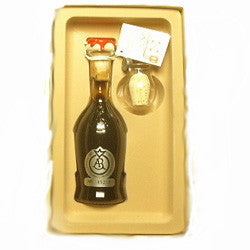Imported Italy
Venturini Baldini GOLD LABEL Balsamic Vinegar
Venturini Baldini GOLD LABEL Balsamic Vinegar
Couldn't load pickup availability
There are very few cases like Traditional Balsamic Vinegar, where its history is “the product”. In fact, this fruit of the intelligence and the passion of men has honoured and characterised the most fortunate and most knowledgeable tables for many centuries. Its ancient roots are for the most part unknown, and surround the “most special vinegar in the world” with a veil of mystery, about where the idea and the production techniques came from, the beginning of the modus operandi passed down through the generations from father to son, which today we call know how. The earliest ancient writings which mention it date back to the year 1046, when the Emperor of Germany, Henry II, travelling to Rome for the coronation, stopped in Piacenza. From here he wrote to Boniface, Marquis of Tuscany and father of the famous Countess Matilde of Canossa, asking for a gift of a special vinegar which “he had heard flows in the most perfect manner”. Within the very walls of the castle which was to become very famous a few years later for the “pardon” meeting between Pope Gregory VII and the Emperor Henry IV, the story goes that a vinegar was made, elixir and balsam, which was craved desperately by the royalty. These historic facts are told in the poem “Vita Mathildis”, written by the monk Donizone, who was the mainbiographer of the Great Countess Matilde. In the XII, XIII and XIV centuries, we know for sure that, in Reggio Emilia, Scandiano and in the other main towns of the territory, vinegar producers formed real consortium-type groups in which all members jealously guarded the secrets of this most precious production. The earliest ancient writings which mention it date back to the year 1046, when the Emperor of Germany, Henry II, travelling to Rome for the coronation, stopped in Piacenza. From here he wrote to Boniface, Marquis of Tuscany and father of the famous Countess Matilde of Canossa, asking for a gift of a special vinegar which “he had heard flows in the most perfect manner”. Within the very walls of the castle which was to become very famous a few years later for the “pardon” meeting between Pope Gregory VII and the Emperor Henry IV, the story goes that a vinegar was made, elixir and balsam, which was craved desperately by the royalty. These historic facts are told in the poem “Vita Mathildis”, written by the monk Donizone, who was the mainbiographer of the Great Countess Matilde. In the XII, XIII and XIV centuries, we know for sure that, in Reggio Emilia, Scandiano and in the other main towns of the territory, vinegar producers formed real consortium-type groups in which all members jealously guarded the secrets of this most precious production. After the imperial imprimatur, during the whole Renaissance period, Balsamic Vinegar often appeared on the tables of the kings and the nobility, particularly at the table of the Dukes of Este. When Alfonso I, Duke of Ferrara, came to reign in 1476, the history of balsamic vinegar received a decisive boost. The whole of the ruling dynasty in the duchy of Modena, Reggio Emilia and Massa, across the centuries up until 1859, enriched the accounts of the history of Traditional Balsamic Vinegar. Lodovico Ariosto, not by chance from Reggio Emilia, writes in the third of his Satires dedicated to his cousin Annibale Malaguzzi, “at my house I’d rather have a turnip to cook, and cooked on a stick I take and mash and spread with a little vinegar and must”. In 1863, in a publication by Fausto Sestini, we can clearly read that “in the provinces of Modena and Reggio Emilia since ancient times a very special quality of vinegar has been prepared, whose appearance and excellent aroma led them to call it Balsamic Vinegar”. The testimonies of Balsamic Vinegar become more frequent in the 1800’s, particularly in the dowry lists of the noble families from Reggio Emilia. At that time it was in fact customary to enrich the dowry of the noble women who were to be married with jars of precious balsamic vinegar and sets of little barrels with the same precious content. The rest is history of our times.
Share

Introduce your content
Answer your customers' common questions
List a frequently asked question
Then provide an answer that will help your customer make an informed purchase.

